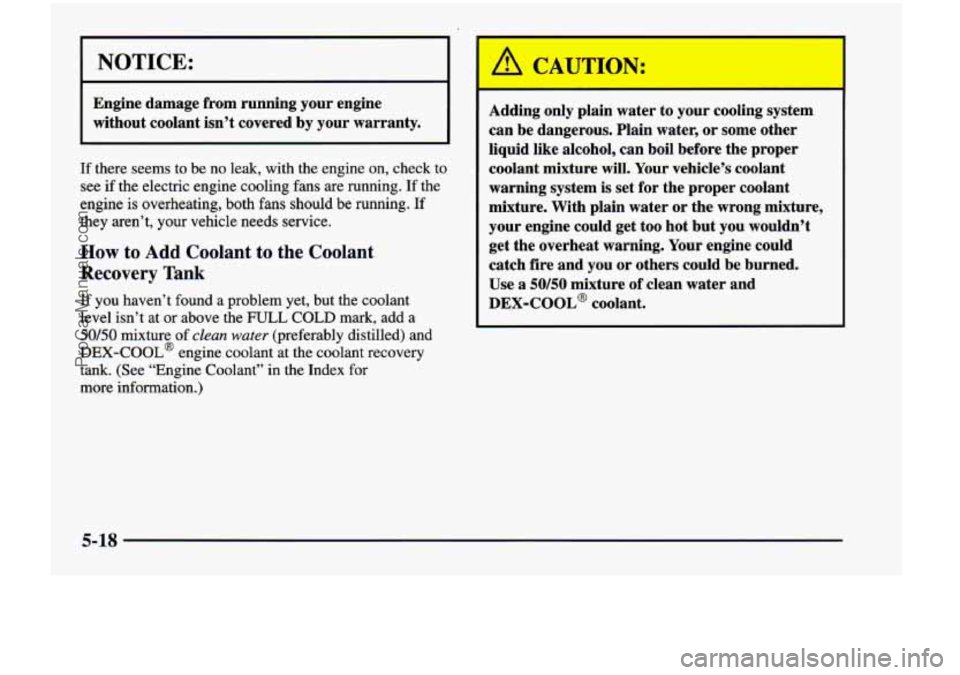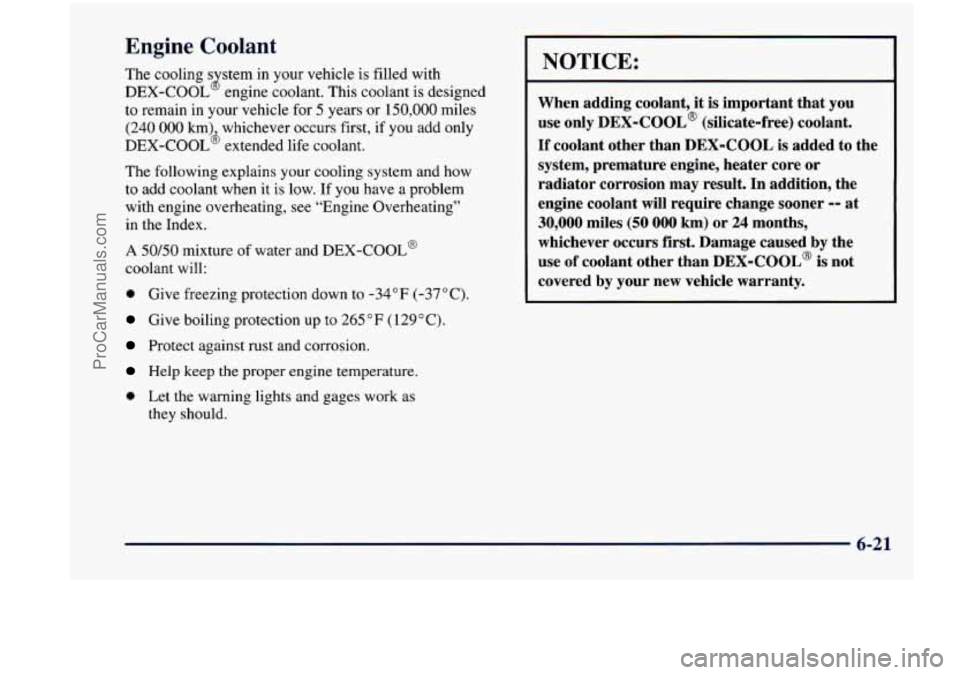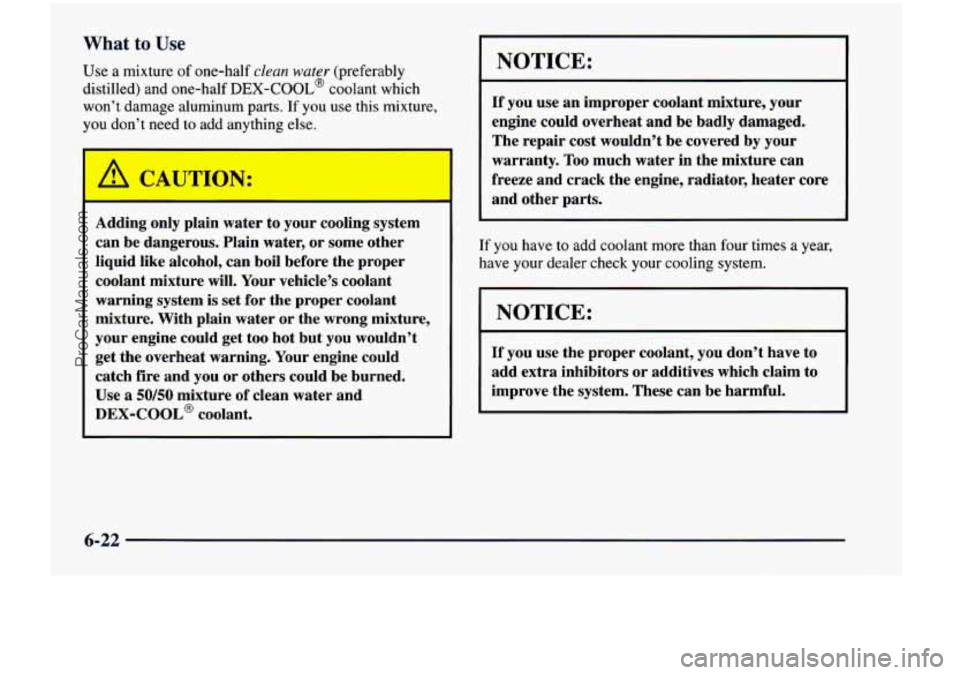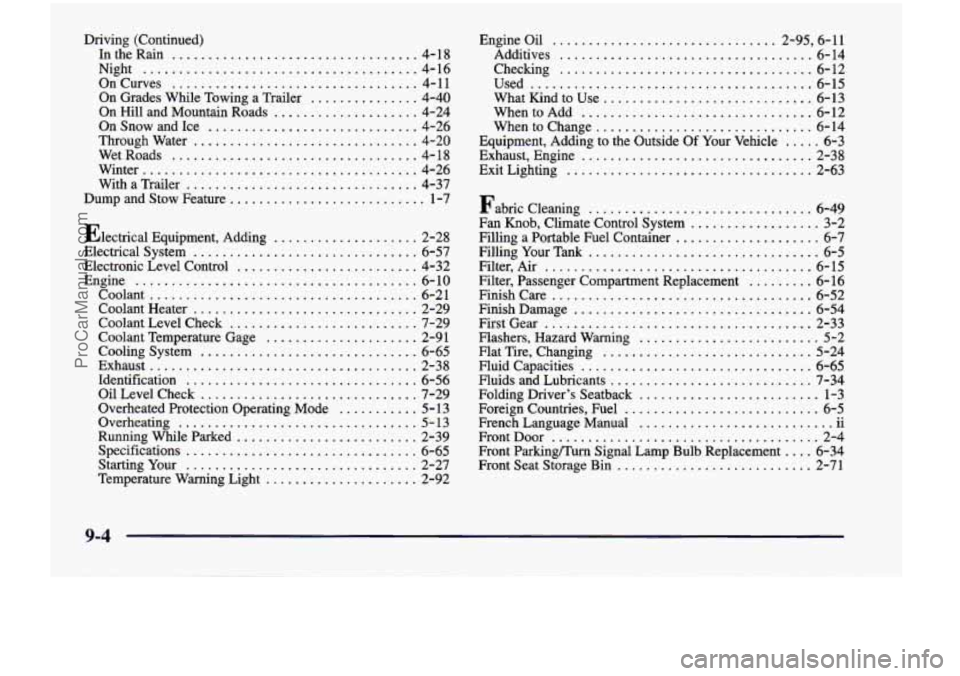1998 CHEVROLET VENTURE adding oil
[x] Cancel search: adding oilPage 315 of 474

NOTICE:
Engine damage from running your engine
without coolant isn’t covered by your warranty.
If there seems to be no leak, with the engine on, check to
see if the electric engine cooling fans are running. If the
engine is overheating, both fans should be running. If
they aren’t, your vehicle needs service.
How to Add Coolant to the Coolant
Recovery Tank
If you haven’t found a problem yet, but the coolant
level isn’t
at or above the FULL COLD mark, add a
50/50 mixture of clean water (preferably distilled) and
DEX-COOL’ engine coolant at the coolant recovery
tank. (See “Engine Coolant” in the Index for
more information.)
A CAUTION:
Adding only plain water to your cooling system
can be dangerous. Plain water,
or some other
liquid like alcohol, can boil before the proper
coolant mixture will. Your vehicle’s coolant
warning system is set for the proper coolant
mixture. With plain water or the wrong mixture,
your engine could get
too hot but you wouldn’t
get the overheat warning.
Your engine could
catch fire and you or others could be burned.
Use a
50/50 mixture of clean water and
DEX-COOL@ coolant.
5-18
ProCarManuals.com
Page 356 of 474

Engine Coolant
The cooling s stem in your vehicle is filled with
DEX-COOL engine coolant. This coolant is designed
to remain
in your vehicle for 5 years or 150,000 miles
(240 000 km) whichever occurs first, if you add only
DEX-COOLd extended life coolant.
J
The following explains your cooling system and how
to add coolant
when it is low. If you have a problem
with engine overheating, see “Engine Overheating”
in the Index.
A 50/50 mixture of water and DEX-COOL@
coolant will:
0 Give freezing protection down to -34°F (-37°C).
Give boiling protection up to 265 OF ( 129 O C).
Protect against rust and corrosion.
Help keep the proper engine temperature.
0 Let the warning lights and gages work as
they should.
~
~
NOTICE:
When adding coolant, it is important that you
use
only DEX-COOL@ (silicate-free) coolant.
If coolant other than DEX-COOL is added to the
system, premature engine, heater core or
radiator corrosion may result. In addition, the
engine coolant will require change sooner
-- at
30,000 miles (50 000 km) or 24 months,
whichever occurs
first. Damage caused by the
use
of coolant other than DEX-COOL@ is not
covered by your new vehicle warranty.
6-21
ProCarManuals.com
Page 357 of 474

What to Use
Use a mixture of one-half clean water (preferably
distilled) and one-half
DEX-COOL@ coolant which
won’t damage aluminum
parts. If you use this mixture,
you don’t need to add anything else.
I
I
Adding only plain water to your cooling system
can be dangerous. Plain water, or some other
liquid like alcohol, can boil before the proper
coolant mixture will. Your vehicle’s coolant
warning system is set for
the proper coolant
mixture. With plain water or the wrong mixture,
your engine could get too hot but you wouldn’t
get the overheat warning. Your engine could
catch fire and you or others could be burned.
Use
a 50/50 mixture of clean water and
DEX-COOL@ coolant.
NOTICE:
If you use an improper coolant mixture, your
engine could overheat and be badly damaged.
The repair cost wouldn’t be covered by your
warranty.
Too much water in the mixture can
freeze and crack the engine, radiator, heater
core
and other parts.
If you have to add coolant more than four times a year,
have your dealer check your cooling system.
NOTICE:
If you use the proper coolant, you don’t have to
add extra inhibitors or additives which claim
to
improve the system. These can be harmful.
6-22
ProCarManuals.com
Page 400 of 474

Capacities and Specifications
The following approximate capacities are given in
English and metric conversions.
Please refer to “Recommended Fluids and Lubricants”
in the Index for more information.
Automatic Transaxle
Pan Removal and Replacement ..... 8 quarts (7.5 L)
Cooling System
With A/C .................... 9.6 quarts (9.1 L)
With Rear Climate Control or
Engine Crankcase - Oil and
Fuel Capacity
Rear Heater ................ 11.9 quarts (11.3 L)
Filter Change ............... 4.5 quarts (4.3 L)
StandardRegular .............. .20 gallons (76 L)
OptionaVExtended ............. .25 gallons (95 L)
Refrigerant, Air Conditioning* . . See Refrigerant
Label under the hood.
Tire Pressures, Sizes ........... See Tire-Loading
Information label
on driver’s door.
Wheel Nut Torque .......... 100 lb-ft (140 N-m)
Windshield Washer Fluid ....... 1 gallon (0.37 L)
*See Air Conditioning Refrigerants later in
this section.
NOTE: All capacities are approximate. When
adding,
be sure to fill to the appropriate level, as
recommended in
this manual.
Engine Specifications
Engine VIN Code ........................... E
Firing Order ...................... 1-2-3-4-5-6
EngineType
.............................. V6
Horsepower ............................. 180
Thermostat
Temperature
Specification
................... 195 “F (91 “C)
6-65
ProCarManuals.com
Page 461 of 474

Driving (Continued) IntheRain
.................................. 4-18
On Curves
.................................. 4- 11
On Grades While Towing a Trailer ............... 4-40
On Hill and Mountain Roads
.................... 4-24
OnSnowandIce
............................. 4-26
Wet Roads
.................................. 4-18
Winter
...................................... 4-26
WithaTrailer
................................ 4-37
Night
...................................... 4-16
Through Water
............................... 4-20
Dump and Stow Feature
........................... 1-7
Electrical Equipment. Adding
.................... 2-28
Electrical
System ............................... 6-57
Electronic Level Control
......................... 4-32
Engine
....................................... 6-10
Coolant
..................................... 6-21
Coolant Heater
............................... 2-29
Coolant Level Check
.......................... 7-29
Coolant Temperature Gage
..................... 2-9 1
Cooling System .............................. 6-65
Exhaust
..................................... 2-38
Identification
................................ 6-56
Oil Level Check
.............................. 7-29
Overheated Protection Operating Mode
........... 5- 13
Overheating
................................. 5-13
Running While Parked
......................... 2-39
Specifications
................................ 6-65
StartingYour
................................ 2-27
Temperature Warning Light
..................... 2-92 Engine
Oil ............................... 2.95. 6.11
Checking
................................... 6-12
Additives
................................... 6-14
Used
....................................... 6-15
What Kind to Use
............................. 6-13
WhentoAdd
................................ 6-12
When to Change
.............................. 6-14
Equipment. Adding to the Outside Of Your Vehicle ..... 6-3
Exhaust. Engine
................................ 2-38
Exit Lighting
.................................. 2-63
Fabric Cleaning
............................... 6-49
Fan Knob. Climate Control System .................. 3-2
FillingYourTank
................................ 6-5
Filter. Air
..................................... 6-15
Filter. Passenger Compartment Replacement
......... 6-16
Finishcare
.................................... 6-52
Finish Damage
................................. 6-54
FirstGear
..................................... 2-33
Flashers. Hazard Warning
......................... 5-2
Flat Tire. Changing
............................. 5-24
Fluid Capacities
................................ 6-65
Fluids and Lubricants
............................ 7-34
Folding Driver’s Seatback
......................... 1-3
Foreign Countries. Fuel
........................... 6-5
Filling a Portable Fuel Container
.................... 6-7
FrenchLanguageManual
........................... ii
FrontDoor
..................................... 2-4
Front ParkingEurn Signal Lamp Bulb Replacement
.... 6-34
Front Seat Storage Bin
........................... 2-71
9-4
. . .
ProCarManuals.com